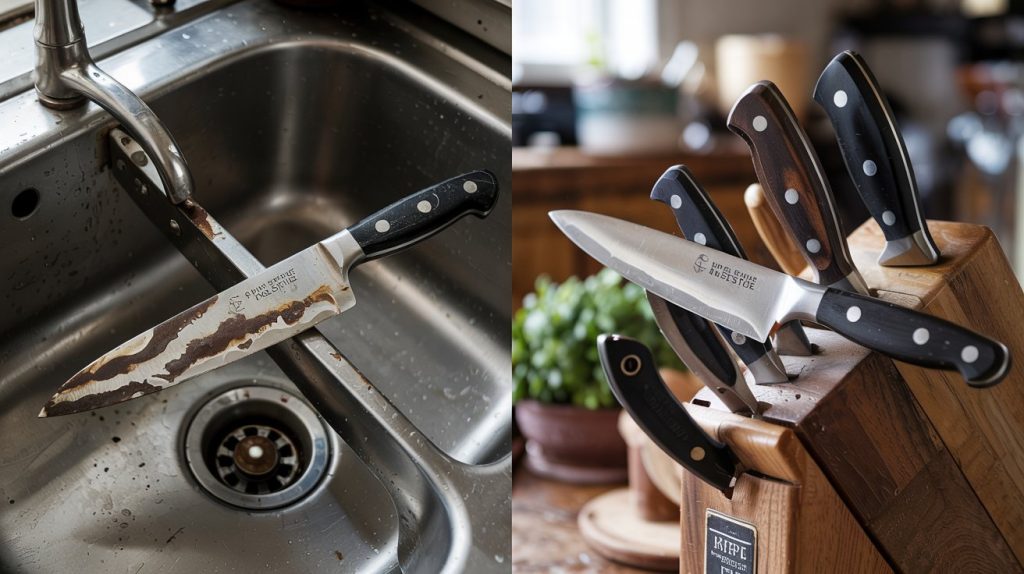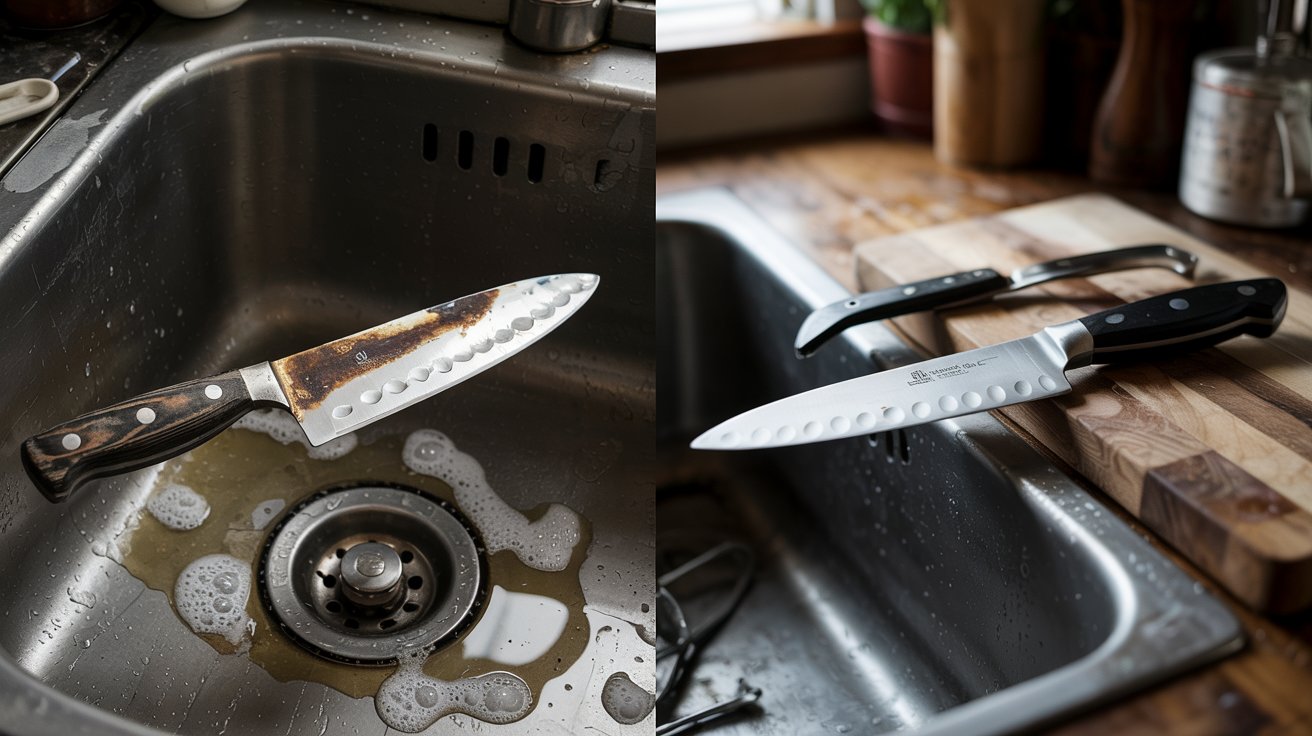A great chef knife is every cook’s ultimate weapon. But even the sharpest, most expensive blade can lose its edge if it’s not properly cared for. Whether you’re a home cook dabbling in gourmet meals or a professional chef slicing through busy kitchen shifts, avoiding common mistakes can significantly extend your knife’s lifespan.
This guide will walk you through the top 10 mistakes people make with their chef knives and offer 5 quick fixes to keep your blade razor-sharp for years to come. Let’s dig in.
Top 10 Chef Knife Care Mistakes
1. Using a Dishwasher
It can be tempting to toss your knife into the dishwasher after a long day of cooking, but this is one of the worst things you can do for your chef knife. The high heat and harsh detergents can cause the blade to dull, weaken the edge, and even damage the handle over time.
Why it matters: Detergent chemicals can corrode the metal, and the movement inside the dishwasher can chip your blade.
Quick Fix: Hand wash your knife immediately after use with warm water, mild soap, and a soft sponge. Dry it thoroughly to avoid water stains.
2. Improper Storage
Throwing your chef knife into a drawer with other utensils is a recipe for disaster. This practice almost guarantees nicks and chips in the blade.
Why it matters: Blade collisions with other hard objects can damage the edge and shorten your knife’s effectiveness.
Quick Fix: Use a magnetic knife strip, a dedicated knife block, or knife guards to keep your blades protected and separated.
3. Cutting on the Wrong Surfaces
Using your chef knife on hard surfaces like glass, metal, or ceramic cutting boards is a fast track to a dull or chipped blade.
Why it matters: Hard surfaces are unforgiving and put unnecessary strain on your knife’s edge.
Quick Fix: Stick to wooden or bamboo cutting boards, which are knife-friendly and gentle on the edge.
4. Not Honing Your Knife Regularly
Many people confuse honing with sharpening, but the two are not the same. Honing realigns your knife’s edge, while sharpening removes metal to create a new edge.
Why it matters: Without regular honing, even the sharpest blade will feel dull over time.
Quick Fix: Use a honing rod (steel) regularly, ideally after every use, to maintain the sharpness of your blade.
5. Sharpening Too Often or Improperly
While sharpening is essential, overdoing it can wear down the blade unnecessarily. Worse, sharpening at the wrong angle could ruin the knife entirely.
Why it matters: Every time you sharpen a knife, you remove a small amount of metal. Too much sharpening can shorten the lifespan of the blade.
Quick Fix: Sharpen your chef knife sparingly (every few months or as needed) and use professional sharpening tools or services for precise results.
6. Leaving It Wet
Leaving your knife wet after washing or using it to slice acidic ingredients can cause rust and corrosion, especially on high-carbon steel blades.
Why it matters: Water and certain foods can eat away at your blade’s surface, weakening it over time.
Quick Fix: Always dry your knife immediately after washing or use. Use a soft microfiber cloth for the perfect finish.
7. Ignoring Regular Maintenance
Even the best knives need occasional TLC. Ignoring maintenance will lead to dullness, chipped edges, or even a broken blade.
Why it matters: Regular upkeep is key to preventing small issues from snowballing into significant problems.
Quick Fix: Schedule periodic deep care for your knives, including professional sharpening, and inspect them for wear and tear.
8. Using the Blade for the Wrong Tasks
Using your chef knife to pry open jars, cut through bones, or scrape food off a cutting board is a fast way to damage it.
Why it matters: Knives are not multi-tools; incorrect use can bend or chip the blade.
Quick Fix: Reserve your chef knife for slicing and dicing. Use specialty tools like a cleaver or jar opener for tougher tasks.
9. Lack of Grip Awareness
Applying uneven pressure or holding the knife incorrectly can result in a damaged blade or, worse, an injury.
Why it matters: A firm, consistent grip allows you to use the blade to its full potential without straining it.
Quick Fix: Practice holding your knife properly, with a firm grip on the handle and your fingers away from the blade.
10. Neglecting the Handle
While the blade often gets all the attention, the handle is equally important. A loose or cracked handle can make your knife unusable.
Why it matters: A damaged handle affects grip and control, compromising safety and precision.
Quick Fix: Inspect the handle regularly for damages and repair or replace it when necessary.

5 Quick Fixes to Save Your Blade’s Lifespan
1. Create a Dedicated Knife Care Schedule
Take 10 minutes every month to inspect your knives for wear and tear. Implement regular honing sessions and plan sharpening as needed.
2. Invest in the Right Tools
Equip your kitchen with essentials like a honing rod, a proper cutting board, and knife guards. These small investments can significantly extend your knife’s longevity.
3. Learn Proper Handling Techniques
Take a basic knife skills class or watch tutorials to master how to hold, cut, and care for your chef knife like a pro.
4. Opt for High-Quality Maintenance Services
Don’t hesitate to rely on a professional knife sharpening service to ensure your knife remains razor-sharp and well-balanced.
5. Store Smarter
Whether it’s a magnetic strip or a knife organizer drawer, ensure your knives are stored safely and securely between uses.
Perfect Your Knife Care Routine
A well-cared-for chef knife is more than just a tool; it’s an extension of your skill and passion in the kitchen. With proper care and attention, your blade can remain as sharp and reliable as the day you first unboxed it.
By avoiding these common mistakes and implementing the quick fixes described above, you can extend the life of your favorite knife while improving your cooking experience. Whether you’re a home cook or a professional chef, taking care of your chef knife is a step toward mastering your craft.
Happy slicing!




